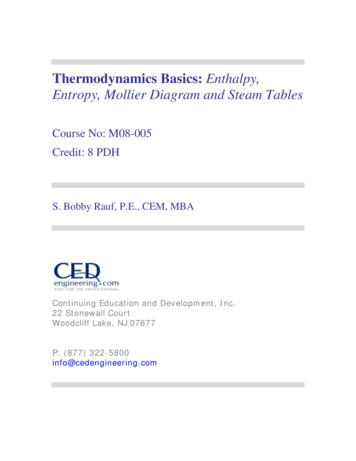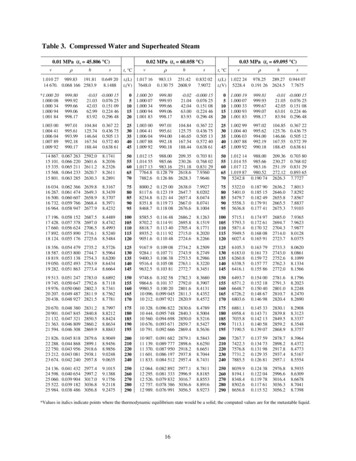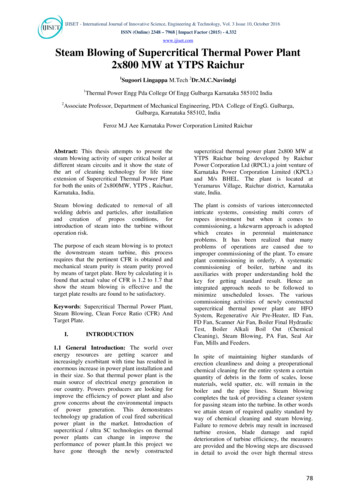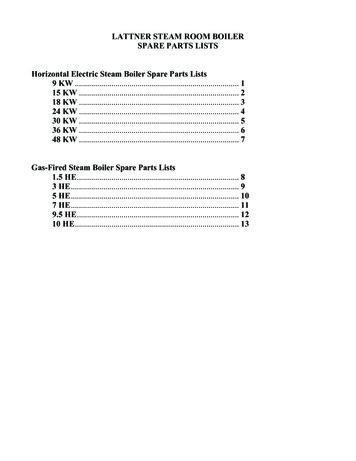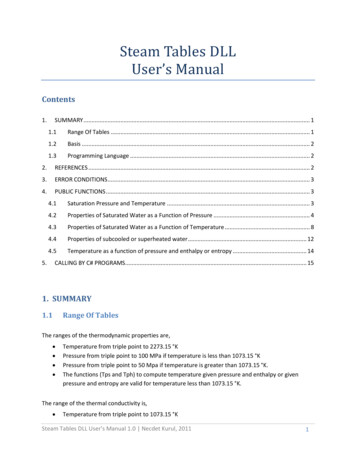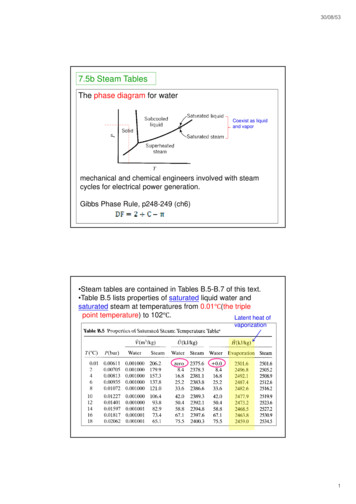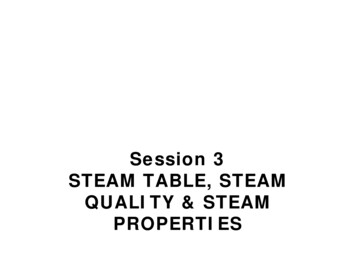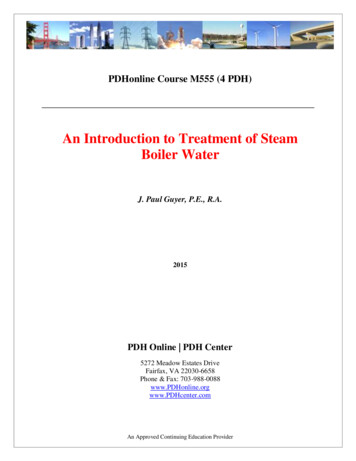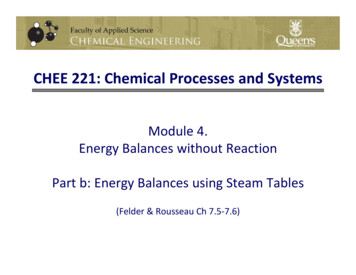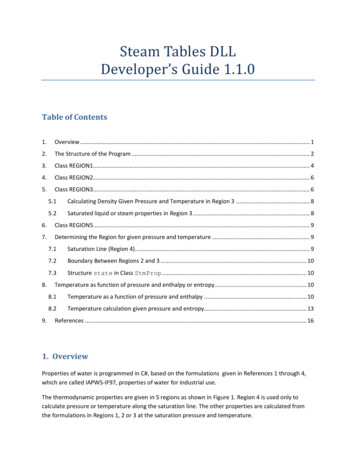
Transcription
Steam Tables DLLDeveloper’s Guide 1.1.0Table of Contents1.Overview . 12.The Structure of the Program . 23.Class REGION1. 44.Class REGION2. 65.Class REGION3. 65.1Calculating Density Given Pressure and Temperature in Region 3 . 85.2Saturated liquid or steam properties in Region 3 . 86.Class REGION5. 97.Determining the Region for given pressure and temperature . 98.9.7.1Saturation Line (Region 4). 97.2Boundary Between Regions 2 and 3 . 107.3Structure state in Class StmProp . 10Temperature as function of pressure and enthalpy or entropy . 108.1Temperature as a function of pressure and enthalpy . 108.2Temperature calculation given pressure and entropy. 13References . 161. OverviewProperties of water is programmed in C#, based on the formulations given in References 1 through 4,which are called IAPWS-IF97, properties of water for industrial use.The thermodynamic properties are given in 5 regions as shown in Figure 1. Region 4 is used only tocalculate pressure or temperature along the saturation line. The other properties are calculated fromthe formulations in Regions 1, 2 or 3 at the saturation pressure and temperature.
Properties in Region 2 are calculated for stable steam, metastable states are not included.As shown in Figure 1, properties are calculated as a function of pressure and density. Functions for thedependency of temperature corresponding to given pressure and density are also given in Reference 1.The transport properties (thermal conductivity and viscosity) are calculated based on the formulationsgiven in References 3 and 4. Since the transport properties are expressed in terms of temperature anddensity, calculation of density for given pressure and temperature is also needed in the computations.Therefore the transport properties are also not valid outside the regions shown in Figure 1. The terms inthe viscosity and thermal conductivity formulations that improve the precision (see References 3 and 4)are not included. This implementation is also that used in the ASME Steam Tables for Industrial Use.Figure 1. Regions of IAPWS-IF97 formulation (Reference 1)2. The Structure of the ProgramAll of the classes are within the same namespace, “SteamProperties”. There is one class correspondingto each of Regions 1, 2, 3 and 5, in which all thermodynamic properties belonging to the respectiveregion are calculated based on the Gibbs or Helmholtz function and their derivatives. The transportproperties (viscosity and thermal conductivity) are calculated from the functions given in References 3and 4. The transport property functions are much simpler and shorter as compared to thethermodynamic property functions.
The classes as listed below.StmPropContains the public functions for the properties. This class contains all of the interface functions ofthe DLL, hence an instance of this class must be created by the calling program (see User’s Manualfor examples). Also included in this class are functions for pressure as a function of temperatureand temperature as a function of pressure along the saturation line, and along the boundarybetween regions 2 and 3. This class creates one instance of each of the following classes atinitialization.The interface routine are listed in the User’s Manual and not repeated here.REGION1Contains all thermodynamic property calculations in Region 1.REGION2Contains all thermodynamic property calculations in Region 2.REGION3Contains all thermodynamic property calculations in Region 3.REGION5Contains all thermodynamic property calculations in Region 5.TRANSPORTContains transport property (thermal conductivity and viscosity) functions.Although the formulation in IAPWS-IF97 does not require numerical iterations and hence much faster tocompute than IAPWS-67, the property functions are lengthy in all regions and even lengthier in Region3. It can be noticed that the same derivatives are used in computing multiple properties. To improvecomputation efficiency, the values of the derivatives are saved in each class from one call to the next. Ifthe next call to the DLL is also for the same pressure and temperature value, the functions and theirderivatives are not recalculated, rather, previously calculated values are used.On entry into the public functions, the input values are checked for validity. If the input temperature orpressure is out of bounds, stat is set to 1 and errorMessage is set.The calling program should not be using this package if its intended application range exceeds that inFigure 1. However, many programs may go through too high or too low pressure / temperature states
during the iterations although the converged solution is expected to be well within the range ofapplication, and recover from it. In order to support calling programs that are not written with a goodpractice of error checking, the DLL always returns a reasonable number so that the calling programwould not crash during the iterations. For this purpose, the properties are calculated at the closest validpoint to the input when the inputs are out of bounds, and the calling program may continue with theiterations even when the nonzero return value of stat (error status) is ignored. However if the input tothe steam tables is a NonNumber, a crash may still occur.3. Class REGION1REGION1 includes all raw properties within Region 1 shown in Figure 1. Region 1 includes subcooledliquid except a small section near critical power. The formulation is given in Reference 1.The properties are calculated from the Gibbs function and its derivatives as a function of pressure andtemparature. For example,v g p TFirst, the Gibbs function, g and its derivatives as a function of reduced pressure and temperature arecalculated from the polynomials given in Reference 1 as a function of pressure and temperature. Thefunctions are,Table 3.1 Fundamental Functions in Region 1double G1(double p, double t) , double G1 p(double p, double t) , double G1 t(double p, double t) , double G1 pp(double p, double t) 2 , 2 double G1 tt(double p, double t) 2 , 2 double G1 pt(double p, double t) 2 ,
where , g p, T ) pT, * , * . The reference values (quantities with star superscript)RTTpare given in Reference 1.In each of the functions, the reduced pressure, temperature and the calculated values of the Gibbsfunction and its derivatives are saved in state structure. For as long as the pressure and temperaturevalues do not change, more elements of the state structure are filled each time one of the functions inthe above table is called. When a function is called, the state structure is checked to find if thisfunction has already been calculated for the same pressure and temperature. If the pressure or temperature is not the same as the pressure and temperature in the statestructure, all elements of the state structure are initialized to double.minValue, and thecalculations are performed and the new values are saved in the state structure.If the pressure and temperature are the same as in those in the state structure, but the valuefor this function is still double.minValue, the calculations are performed and the new values aresaved in the state structure.If the pressure and temperature are the same as in those in the state structure, and the valuefor this function exists in state structure, no calculations are performed, the value in statestructure is returned.The following properties are calculated from the relationships given in Reference 1.Table 3.2. Public Functions in Region 1public double V(double p, double t)public double H(double p, double t)public double S(double p, double t)public double CP(double p, double t)public double CV(double p, double t)public double Tph(double p, double h)public double Tps(double p, double s)v ( p, T )pRTh( p, T )RTs ( p, T )Rc p ( p, T )Rcv ( p, T )RT ( p, h)T ( p, s)
4. Class REGION2REGION2 includes all raw properties within Region 2 shown in Figure 1. Region 2 includes superheatedsteam except a small section near critical power. The formulation is given in Reference 1.The structure of this class is similar to that of Class REGION1 in Section 3.5. Class REGION3REGION3 includes all raw properties within Region 3 shown in Figure 1. Region 3 properties are given asa function of temperature and density and derived from the Helmholtz function and its derivatives, alsogiven as a function of temperature and density. The following are the functions to calculate theHelmholtz function and its derivatives.Table 5.1 Fundamental Functions in Region 3double Phi(double r, double t) , double Phi r(double r, double t) , double Phi t(double r, double t) , double Phi rr(double r, double t) 2 , 2 double Phi tt(double r, double t) 2 , 2 double Phi rt(double r, double t)where , 2 , f ,T ) T, * , * . The reference values (quantities with star superscript)RTT are given in Reference 1. In each of the functions, the reduced density, temperature and the calculatedvalues of the Helmholtz function and its derivatives are saved in state structure, similar to that inRegion 1 (see Section 3). The following functions are used to compute the properties.
Table 5.2 Property Functions in Region 3 as a function of density and temperaturedouble Hrt(double r, double t)double Srt(double r, double t)double CPrt(double r, double t)double CVrt(double r, double t)h( , T )RTs( , T )Rcp ( ,T )Rcv ( , T )RProperties as a function of pressure and temperature are calculated in the following functions. Thisfunctions first call Rho to get the density, and then call one of the functions with known density andtemperature in the above table to calculate the property. Also temperature as a function of enthalpy orentropy are included.Table 5.3 Public Functions in Region 3public double Prt(double r, double t)public double Rho(double p, double t, int phase)public double V(double p, double t)public double H(double p, double t)public double S(double p, double t)public double CP(double p, double t)public double CV(double p, double t)public double Tph(double p, double h)public double Tps(double p, double s)p in kPa in kg/m3. SeeSection 5.1v ( p, T )pRTh( p, T )RTs ( p, T )Rc p ( p, T )Rcv ( p, T )RT ( p, h)T ( p, s)
5.1Calculating Density Given Pressure and Temperature in Region 3Since in many practical cases, the pressure and temperature is known, rather than temperature anddensity, additional relationships are needed to find density as a function of pressure and temperature.The density given pressure and temperature is calculated inpublic double Rho(double p, double t, int phase)The formulation for specific volume as a function of pressure and temperature is given in Reference 2.The argument, phase, is only relevant for saturated cases, which will be explained in Section 5.2.Region 3 is divided in many subregions, 3a, 3b, 3z. The subregion is determined in,void SubRegion(double p, double t)using the formulation in Reference 2. This function does not return a value, rather it sets,state.subRegionFunction Rho first checks if the density at the given pressure and temperature has already beencalculated and the phase matches the existing value of phase in state.phase. If so, the density is notrecalculated, rather the value in is state.subRegion returned. If the density has not been calculated atthis point yet, the subregion region is determined by calling SubRegion function, and specific volume isthen calculated by calling the corresponding specific volume function for this subregion, which is one ofVpt 3a, Vpt 3b, , Vpt 3z, using the relationships given in Reference 2.5.2Saturated liquid or steam properties in Region 3Region 3 also includes saturation line between 623.15 K and critical temperature.The saturated liquid density is calculated in Rho with argument phase set to 1, and with pressure andtemperature values on the saturation line. Rho passes the argument phase to function SubRegion. Ifthe subregion corresponding to the given pressure and temperature is one of the subregions adjacent tothe saturation line, the subregion is set to the subregion for subcooled liquid even if it turns out to bethat for saturated steam due to the small differences in pressure and temperature values. Theproperties are then calculated corresponding to the density and temperature for subcooled liquid.Saturated steam properties are calculated similarly by setting the subregion to that corresponding to thesuperheated steam adjacent to the saturation line.Checking state.phase in function Rho before determining whether or not the density should berecalculated or the previously calculated density should be returned ensures that incorrect properties
are not calculated, if for example the first call to Rho is for saturated liquid and the next call is forsaturated steam at the same pressure and temperature.6. Class REGION5REGION5 includes all raw properties within Region 5 shown in Figure 1. Region 5 includes superheatedsteam at high temperature. The formulation is given in Reference 1.The structure of this class is similar to that of Class REGION1 in Section 3. This region does not havetemperature as a function of enthalpy or entropy in this version.7. Determining the Region for given pressure and temperatureAs shown in Figure 1, Regions 1 and 2 are separated by the saturation line below 623.15 K, and by aconstant temperature line above 623.15 K. Regions 2 and 3 are separated by a more or less constantentropy line.The region the state falls into given pressure and temperature is determined in function,public int SubRegion(ref double p, ref double t)This function is in class StmProp, sets the region in the state structure (see Section 0) and returns theregion number.7.1Saturation Line (Region 4)There are two functions for the pressure – temperature relationship in StmProp class: double Pi 4 (double t) is pressure as a function of temperature along the saturation line, from triple point to critical temperature.double Theta 4 (double p) is temperature as a function of pressure along the saturationline, from triple point to critical pressure.Note that the triple point is slightly higher than 273.15 K. The saturation temperature and pressurerelationship can be extrapolated to 273.15 K. However, the properties as implemented in this DLL arelimited to temperatures at or above the triple point temperature of 273.16 K.Once the pressure and temperature are calculated from either Pi 4 or Theta 4, the properties ofsaturated liquid is calculated from Region 1 equations, and the properties of saturated steam iscalculated from Region 2 equations if the temperature is less than 623.15 K (see Figure 1). Fortemperatures higher than 623.15 K, both saturated liquid and saturated steam are calculated fromRegion 3 equations using the appropriate subregion. See Section 5.
7.2Boundary Between Regions 2 and 3There are two functions for the pressure – temperature relationship in StmProp class: double P23(double t) is pressure as a function of temperature along the boundarybetween Regions 2 and 3. double T23(double p) is temperature as a function of pressure along the boundarybetween Regions 2 and 3.7.3Structure state in Class StmPropThe state structure saves the pressure, temperature, quality and region at the last calculated point. Thisstructure is public and the elements can be interrogated by the calling program to determine the qualityand region of the last calculated state.8. Temperature as function of pressure and enthalpy or entropyCalculation of Temperature as a function of pressure and enthalpy or entropy are in Regions 1, 2 and 3,is described in this section.Since the region boundaries are given in terms of pressure and temperature, it is necessary to developan additional algorithm to first determine the region given pressure and enthalpy or entropy beforecalling the property functions in each region. This is accomplished in functions Tph and Tps in classStmProp.8.1Temperature as a function of pressure and enthalpyTemperature, given pressure and enthalpy is calculated in function Tph. The algorithm to determine theregion is described below.If p 16529.164 kPa (this corresponds to 623.15 K, see Figure 1)First h f p and hg p are calculated.If h h f p , temperature is calculated from Region 1 equations.If h hg p , temperature is calculated from Region 2 equations.If h f p h hg p , the temperature is the saturation temperature.Quality is calculated from,
x h hfhg h fIf 16529.164 kPa p pc ( pc is critical pressure)This can be in Regions 1, 2 or 3.First the saturation enthalpy of liquid, h f p , and steam, hg p , are calculated from Region 3equations. There are three possible cases as follows.1. Saturated caseIf h f p h hg p , this point is in Region 3. Temperature is the saturation temperature.2. Subcooled liquid caseIf h h f p , this point may be in Region 1 or Region 3. Region 1 boundary at constantT 623.15 K (see Figure 1) corresponds to the section in P-h plane after the blue dot in Figure 2.A curve fit to this boundary is as follows.h1 3 p 7.27071 10 18 p 4 - 2.06464 10 12 p3 2.23637 10 7 p 2 - 1.14480 10 2 p 1.80136 103where P is in kPa, and h is in kJ/kg.If h h1 3 p , temperature is calculated from Region 1 equations,If h h1 3 p , temperature is calculated from Region 3 equations.3. Superheated steam caseThe temperature at the boundary of Regions 2 and 3 is calculated from T23 in Section 7.2.Corresponding enthalpy at the boundary, h2 3 p is calculated from Region 2 equations.If h h2 3 p , temperature is calculated from Region 2 equations,If h h2 3 p , temperature is calculated from Region 3 equations.Quality is calculated from,x h hfhg h f(1)
If p pc ( pc is critical pressure)A curve is fit to Region 2 boundary in P-h plane was made in two sections,For p 40000 kPah2 3 p -1.53693 10 15 p 4 1.99564 10 10 p3 - 9.49050 10 6 p 2 1.94414 10 1 p 1.17743 103(2)For p 40000 kPah2 3 p 8.04207 10 18 p 4 - 2.67059 10 12 p3 3.33749 10 7 p 2 - 1.46824 10 2 p 2.81053 103(3)where P is in kPa, and h is in kJ/kg. The curve fits are not very accurate as critical pressure isapproached, but the error is less than 10 kJ/kg. One iteration is sufficient to determine thecorrect region as described below.If h h1 3 p 10 , temperature is calculated from Region 1 equations. 10 kJ/kg is added toaccount for uncertainties in Equation (1). The region is checked again by calling SubRegion(p,t).If region is 1, the calculated temperature is the correct temperature, and no further calculationsare needed.If region is not 1, temperature may be in regions 2 or 3. Boundary between regions 2 and 3,h2 3 p , is calculated from Equations (2) or (3), depending on the pressure.If h h2 3 p 10 , temperature is calculated from Region 2 equations. 10 kJ/kg is subtractedto account for uncertainties in Equations (2) and (3).If h h1 3 p , temperature is calculated from Region 3 equations. The region is checked againby calling SubRegion(p,t). If region is 2, the calculated temperature is the correct temperature,and no further calculations are needed. If region is not 2, the given (p,h) state is in Region 3, andtemperature is calculated from Region 3 equations.
Figure 2. Region Boundaries in P-h Plane8.2Temperature calculation given pressure and entropyTemperature, given pressure and entropy is calculated in function Tps. The algorithm to determine theregion is described below. This is analogous to the calculation of temperature given pressure andenthalpy described in Section 8.2.If p 16529.164 kPa (this corresponds to 623.15 K, see Figure 1)First s f p and sg p are calculated.If s s f p , temperature is calculated from Region 1 equations.If s sg p , temperature is calculated from Region 2 equations.If s f p s sg p , the temperature is the saturation temperature.
Quality is calculated from,x s sfsg s fIf 16529.164 kPa p pc ( pc is critical pressure)This state can be in Regions 1, 2 or 3.First the saturation entropy of liquid, s f p , and steam, sg p , are calculated from Region 3equations. There are three possible cases as follows.1. Saturated caseIf s f p s sg p , this point is in Region 3. Temperature is the saturation temperature.2. Subcooled liquid caseIf s s f p , this point may be in Region 1 or Region 3. Region 1 boundary at constantT 623.15 K (see Figure 1) corresponds to the section in P-s plane after the blue dot in Figure 3.A curve fit to this boundary is as follows.s 3.76683 10 11 p 2 8.36729 10 6 p 3.86940where P is in kPa, and s is in kJ/kg K.If s s1 3 p , temperature is calculated from Region 1 equations,If s s1 3 p , temperature is calculated from Region 3 equations.3. Superheated steam caseThe temperature at the boundary of Regions 2 and 3 is calculated from T23 in Section 7.Corresponding entropy at the boundary, s2 3 p is calculated from Region 2 equations.If s s2 3 p , temperature is calculated from Region 2 equations,If s s2 3 p , temperature is calculated from Region 3 equations.Quality is calculated from,x s sfsg s f(1)
If p pc ( pc is critical pressure)A curve is fit to Region 2 boundary in P-h plane was made in two sections,For p 40000 kPas 2.11798 10 26 p 6 3.88682 10 21 p5 2.95203 10 16 p 41.18836 10 11 p3 2.67319 10 7 p 2 3.17149 10 3 p 1.01618 101(2)For p 40000 kPas 2.96307 10 25 p5 1.17911 10 19 p 4 1.89365 10 14 p3 1.54787 10 9 p 2 6.35368 10 5 p 6.08131(3)where P is in kPa, and s is in kJ/kg K. The curve fits are not very accurate as critical pressure isapproached, but the error is less than 0.05 kJ/kg K. One iteration is sufficient to determine thecorrect region as described below.If s s1 3 p 0.05 , temperature is calculated from Region 1 equations. 0.05 kJ/kg K is addedto account for uncertainties in Equation (1). The region is checked again by callingSubRegion(p,t). If region is 1, the calculated temperature is the correct temperature, and nofurther calculations are needed.If region is not 1, this state may be in regions 2 or 3. Boundary between regions 2 and 3,s2 3 p , is calculated from Equations (2) or (3), depending on the pressure.If s s2 3 p 0.05 , temperature is calculated from Region 2 equations. 0.05 kJ/kg K issubtracted to account for uncertainties in Equations (2) and (3).If h h1 3 p , temperature is calculated from Region 3 equations. The region is checked againby calling SubRegion(p,t). If region is 2, the calculated temperature is the correct temperature,and no further calculations are needed. If region is not 2, the given (p,h) state is in Region 3, andtemperature is calculated from Region 3 equations.
Figure 3. Region Boundaries in P-s Plane9. References1. “Revised Release on the IAPWS Industrial Formulation 1997 for the Thermodynamic Properties ofWater and Steam,” The International Association for the Properties of Water and Steam, August2007 (can be obtained from http://www.iapws.org).2. “Supplementary Release on Backward Equations for Specific Volume as a Function of Pressure andTemperature v(p,T) for Region 3 of the IAPWS Industrial Formulation 1997 for the ThermodynamicProperties of Water and Steam,” The International Association for the Properties of Water andSteam, July 2005 (can be obtained from http://www.iapws.org).3. “Release on the IAPWS Formulation 2008 for the Viscosity of Ordinary Water Substance,” TheInternational Association for the Properties of Water and Steam, September 2008 (can be obtainedfrom http://www.iapws.org).
4. “Revised Release on the IAPS Formulation 1985 for the Thermal Conductivity of Ordinary WaterSubstance,” The International Association for the Properties of Water and Steam, September 2008((can be obtained from http://www.iapws.org).5. “Revised Supplementary Release on Backward Equations for the Functions T(p,h), v(p,h) and T(p,s),v(p,s) for Region 3 of the IAPWS Industrial Formulation 1997 for the Thermodynamic Properties ofWater and Steam,” The International Association for the Properties of Water and Steam, September2004 (can be obtained from http://www.iapws.org).
This implementation is also that used in the ASME Steam Tables for Industrial Use. Figure 1. Regions of IAPWS-IF97 formulation (Reference 1) 2. The Structure of the Program All of the classes are within the same names
